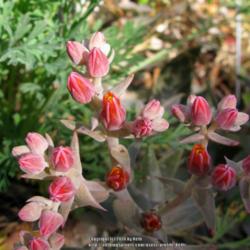Coastal Dudleya from central and northern California, just into Oregon. Leaves may be pale green or usually a powder-dusted pale blue. Rosettes may branch extensively. Flowers are cup-shaped and pale yellow, appearing in late spring and summer (later than coastal Dudleya species found to its south), and attracting hummingbirds.

Widespread coastal and inland Dudleya from California with yellow or red flowers. Leaves vary in color from greenish to yellow, brown, or reddish, but tend to be whitish when they emerge. They may die off in the summer. Stems are very short and solitary or branching into 2-4 rosettes from 2-5 inches wide each. Flowers are tubular and upright and often very colorful. They may be yellow, red, or red with orange or yellow inside.

There are two versions of this rosette succulent, a powder-dusted bluish white one and a powder-free pale green one. Different looking but the flower is almost identical so they have been lumped. Both are found in northwestern Baja California distributed along the immediate vicinity of the coast, roughly from Rosarito to Puerto Santo Tomás. This location has an exceptionally mild, often foggy climate with dry summers and wet winters.

Large, widespread, glaucous white Dudleya from California, Baja California, and Arizona with red tubular flowers. Leaves are usually very glaucous and rosettes are usually (but not always) solitary. A pioneer species. Stems of the type subspecies are the widest of any Dudleya species, and stems may grow decumbent to about 18" long. Rosettes range from about 6" to 30" wide in extreme cases, and are much larger in winter. Best color and form in strong light. May be short lived in containers but can survive decades in the ground.

Open-flowered, branching Dudleya with long green leaves that are round in cross section (terete) and shaped roughly like a pencil. Flowers are white. This was the type species of the old Stylophyllum group of open-flowered Dudleyas, which was named after the aforementioned pencil. Found from Orange County to just SW of Santo Tomas in Baja California. This species was named for the edible leaves (best enjoyed young and fresh after a few winter rains). Generally found near the coast but also up to 3000 feet, in sand, rocks, or cracks in the rock on sheer rock faces, often in areas with lots of fog. Enjoys excellent drainage in cultivation. Branches by division of the growth point into two, and can form small mounds about a foot in diameter with several rosettes. Flowers may be slightly fragrant.

Exceptionally variable and widespread coastal species whose range spans from Santa Barbara southward to Punta Banda in Baja California. May be solitary (in which case the rosette is often larger, sometimes up to 18 inches) or branch profusely. Dwarf forms may have rosettes measuring 1 inch. Flowers are tubular and usually orange to red, but may also be yellow, purplish-red and very rarely green. Some rosettes may be easy to confuse with the larger D. brittonii, which is found toward the south of lanceolata's range.

Green (powder-free) or whitish (powder-dusted) coastal and island Dudleya with open (spreading), white flowers and flattened, non-viscid leaves. Rosettes tend to branch extensively. Native of the southern Channel Islands, a bit of coastline south of Los Angeles, and Guadelupe Island off Baja California. The various subspecies (formerly species of their own) have distinct origins. This species has absorbed the former D. hassei (Santa Catalina & Guadelupe Islands) and D. insularis (Santa Catalina and San Nicholas Islands, plus the mainland from Point Vicente to Point Fermin). Subspecies virens is restricted to San Clemente Island. Attracts hummingbirds.

endemic to Catalina Island, California. Considered an important 'bird food' plant as hummingbirds enjoy the nectar from the flowers.

Sun-loving, rock-dwelling native of NW Baja California's Pacific coast (also found in near-coastal locations and on Todos Santos and Coronado Islands). The only part of the plant that you usually see is the tuft of inch-long gray/green/blue/brown leaves, but mature plants can grow a (relatively) extended stem beneath, covered by dead leaves and dry flower stalks. D. attenuata survives on coastal fog and winter rains in a place that has very little water otherwise, but no temperature extremes either.

Island endemic from the Coronado Islands off the coast of Baja California near Tijuana. A low, whitish blue, powder-dusted succulent which branches profusely and can grow quite wide over time, relative to the size of individual rosettes (which may reach 8-9 inches in larger clones). This plant may branch by division of the growth point and/or axial branching lower down.
